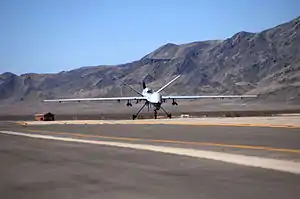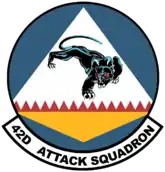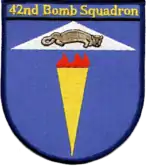42nd Attack Squadron
The 42d Attack Squadron is a dormant United States Air Force unit assigned to the 25th Attack Group and formerly located at Creech Air Force Base near Indian Springs, Nevada. It flew the General Atomics MQ-9 Reaper unmanned aerial vehicle. The 42d oversaw the training and combat deployment of aerial vehicle and sensor operators assigned to the Reaper.
42d Attack Squadron
 | |
|---|---|
 First squadron MQ-9 Reaper at Creech AFB | |
| Active | 1917–1919; 1922–1936; 1940–1963; 2006–2020 |
| Country | |
| Branch | |
| Type | Squadron |
| Role | Unmanned Aerial vehicle |
| Garrison/HQ | Creech Air Force Base, Nevada |
| Decorations | Distinguished Unit Citation Navy Presidential Unit Citation Air Force Meritorious Unit Award Air Force Outstanding Unit Award[1] |
| Commanders | |
| Notable commanders | Lt Gen Roger M. Ramey[1]Maj Gen Orvil A. Anderson[2] |
| Insignia | |
| 42d Attack Squadron emblem (approved 30 November 2009)[1] |  |
| 42d School Squadron emblem (approved 20 January 1925)[3] |  |
Created as the first operational MQ-9 Reaper squadron in 2006,[4] the squadron flew its final sortie and was subsequently placed in a dormant status on 31 January 2020.[5]
History
World War I
The squadron was organized as the 42d Aero Squadron on 17 June 1917, shortly after the United States declared war on Germany. Based at Camp Kelly, Texas, the squadron flight-trained new pilots as part of the Air Service until demobilized on 21 February 1919.
Training between the wars
The squadron was reconstituted in 1922 and became the 42d School Squadron in January 1923 as part of the 10th School Group at Kelly Field. In 1924 its lineage was consolidated with that of the 42d Aero Squadron. The 42d School Squadron continued its flying training role as part of the Air Corps in 1926, and was assigned to the Advanced Flying School at Kelly Field in 1931.
On 1 March 1935, with the activation of the General Headquarters Air Force, the squadron was redesignated the 42d Bombardment Squadron, although it remained a training squadron at Kelly until its inactivation in September 1936.
It was organized once again only a month later, as a Regular Army inactive unit assigned to the Eighth Corps Area, on 23 October 1936.[2] These units remained inactive, but had Organized Reserve officers assigned for training.
World War II
In September 1939, the squadron existed only as an inactive cadre of Organized Reserve officers, centered on Brownsville Municipal Airport, Texas. The squadron was reactivated on 1 February 1940 as part of the expansion of the Air Corps anticipating U.S. participation in World War II. It became part of the 11th Bombardment Group based at Hickam Field, Hawaii. Initially flying Douglas B-18 Bolos, the squadron was converting to Boeing B-17 Flying Fortresses when Hickam was attacked by Japanese carrier aircraft as part of the attack on Pearl Harbor.
The 42d Squadron deployed with the 11th Bombardment Group to Espiritu Santo, where it participated in the Guadalcanal Campaign. It conducted long-range reconnaissance and bombing missions throughout the South, Southwest, Central, and Western Pacific areas until the end of the war, converting to Consolidated B-24 Liberator bombers in 1943.
In 1946, while based on Guam, the 42d BS was briefly equipped with Boeing B-29 Superfortresses, but had no aircraft or flying mission from 1947 to its inactivation on in 1948.
Strategic Air Command
The squadron was reactivated as a unit of the United States Air Force on 1 December 1948. Assigned to the 11th Bombardment Group as part of the Strategic Air Command, it flew Convair B-36 Peacemaker intercontinental bombers from Carswell Air Force Base, Texas. In 1957 it moved to Altus Air Force Base, Oklahoma, to convert to Boeing B-52 Stratofortresses.
In 1960 was reassigned to the 4043d Strategic Wing, being re-equipped with B-52E intercontinental heavy bombers. The squadron moved to Wright-Patterson Air Force Base, Ohio by SAC to disperse its heavy bomber force. Conducted worldwide strategic bombardment training missions and providing nuclear deterrent. Was inactivated in 1963 when SAC inactivated its strategic wings, replacing them with permanent Air Force Wings. Squadron was inactivated with its aircraft, personnel and equipment transferred to the 34th Bombardment Squadron.
Unmanned aerial vehicles
On 9 November 2006, the squadron was redesignated the 42d Attack Squadron and reactivated at Creech Air Force Base, Nevada, initially as part of the 57th Wing before being assigned as one of the six unmanned aerial vehicle squadrons of the 432d Wing, and the only squadron designated as an attack squadron.
The 42d received its first General Atomics MQ-9 Reaper on 13 March 2007. Officially combat-operational in Afghanistan since September 2007, the typical MQ-9 system consists of several aircraft, a ground control station, communications equipment/links, spares, and active duty and/or contractor personnel. The crew consists of one unmanned aerial system pilot, one sensor operator and one mission intelligence coordinator.
Lineage
- 42d Aero Squadron
- Organized as the 42d Aero Squadron on 13 June 1917
- Demobilized on 21 February 1919
- Reconstituted on 8 April 1924 and consolidated with the 42d School Squadron as the 42d School Squadron[1]
- 42d Attack Squadron
- Authorized 10 June 1922 as the 42d Squadron (School)
- Organized on 5 July 1922
- Redesignated 42d School Squadron on 25 January 1923
- Consolidated with the 42d Aero Squadron on 8 April 1924
- Redesignated 42d Bombardment Squadron on 1 March 1935
- Inactivated on 1 September 1936
- Organized as a Regular Army Inactive unit on 23 November 1936[2]
- Redesignated 42d Bombardment Squadron (Medium) on 22 December 1939
- Activated on 1 February 1940
- Redesignated 42d Bombardment Squadron (Heavy) on 11 December 1940
- Redesignated 42d Bombardment Squadron, Heavy c. 1 August 1944
- Redesignated 42d Bombardment Squadron, Very Heavy on 30 April 1946
- Inactivated on 20 October 1948
- Redesignated 42d Bomb Squadron, Heavy and activated on 1 December 1948
- Discontinued and inactivated on 1 February 1963
- Redesignated 42d Attack Squadron and activated on 9 November 2006[1]
- Placed in dormant status on 1 February 2020
Assignments
- Unknown, 13 June 1917 – 21 February 1919 (probably Post Headquarters, Kelly Field and Wilbur Wright Field)
- 10th School Group, 5 July 1922
- Air Corps Advanced Flying School, 16 July 1931
- 3d Wing, GHQ Air Force, 1 March 1935 – 1 September 1936 (attached to Air Corps Advanced Flying School)
- Eighth Corps Area as a Regular Army Inactive unit on 23 November 1936[2]
- 11th Bombardment Group, 1 February 1940 – 20 October 1948
- 11th Bombardment Group, 1 December 1948 (attached to 11th Bombardment Wing after 16 February 1951)
- 11th Bombardment Wing, 16 June 1952
- 4043d Strategic Wing, 1 June 1960
- 57th Operations Group, 9 November 2006
- 432d Operations Group, 1 May 2007[1]
- 25th Attack Group, 12 July 2019
Stations
|
|
Aircraft
- Standard J-1, 1917–1919
- Curtiss JN-4, 1917–1919
- Airco DH.4, 1917–1919, 1923–1931
- Douglas O-2, 1926–1933
- Curtiss O-11 Falcon, 1930–1932
- Thomas-Morse O-19, 1930–1935
- Keystone B-3, 1935–1936
- Keystone B-4, 1935–1936
- Keystone B-5, 1935–1936
- Douglas B-18 Bolo, 1940–1941
- Boeing B-17 Flying Fortress, 1941–1943
- Consolidated B-24 Liberator, 1943–1945
- Boeing B-29 Superfortress, 1946
- Convair B-36 Peacemaker, 1949–1957
- Boeing B-52 Stratofortress, 1958–1963
- General Atomics MQ-1 Predator, 2006–2013
- General Atomics MQ-9 Reaper, 2006–present[1]
Decorations
![]()
- South Pacific, 31 July-30 November 1942
![]()
- Pacific Theater, 7 August-9 December 1942
![]()
- 6 August 1954 – 15 July 1957
- 27 October 1958 – 1 June 1960
- 28 May 2019
![]()
- 15 November 2019
References
- Haulman, Daniel L. (15 May 2012). "Factsheet 42 Attack Squadron (ACC)". Air Force Historical Research Agency. Retrieved 17 February 2017.
- Clay, p. 1406
- Maurer, Combat Squadrons, pp. 193–194
- "First MQ-9 squadron looks good for 100". Retrieved 25 March 2020.
- Rosado, William. "Dormant, not deactivated: 42nd ATKS end of operations". Creech Air Force Base. Retrieved 24 December 2020.
Bibliography
![]() This article incorporates public domain material from the Air Force Historical Research Agency website http://www.afhra.af.mil/.
This article incorporates public domain material from the Air Force Historical Research Agency website http://www.afhra.af.mil/.
- Clay, Steven E. (2011). US Army Order of Battle 1919–1941 (PDF). Vol. 3 The Services: Air Service, Engineers, and Special Troops 1919–1941. Fort Leavenworth, KS: Combat Studies Institute Press. ISBN 978-0-98419-014-0. LCCN 2010022326. OCLC 637712205. Retrieved 16 October 2012.
- Maurer, Maurer, ed. (1983) [1961]. Air Force Combat Units of World War II (PDF) (reprint ed.). Washington, DC: Office of Air Force History. ISBN 0-912799-02-1. LCCN 61060979. Retrieved 17 December 2016.
- Maurer, Maurer, ed. (1982) [1969]. Combat Squadrons of the Air Force, World War II (PDF) (reprint ed.). Washington, DC: Office of Air Force History. ISBN 0-405-12194-6. LCCN 70605402. OCLC 72556. Retrieved 17 December 2016.
- Ravenstein, Charles A. (1984). Air Force Combat Wings, Lineage & Honors Histories 1947–1977. Washington, DC: Office of Air Force History. ISBN 0-912799-12-9. Retrieved 17 December 2016.
Further reading
- Las Vegas Review-Journal, 14 March 2007, Page 3B
External links
- Dumboski, Andrew, A1C, USAF. "First attack squadron stands up at Creech AFB", Nellis AFB Public Affairs, 17 November 2006. Retrieved on 27 January 2007.
- Defense Update. "MQ-9 Reaper Joins First Unmanned Attack Squadron", Defense Update, 2007. Retrieved on 6 May 2007.
